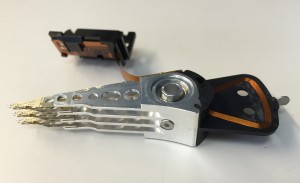
Imagine taking your car to a mechanic that charges a flat rate for every service. Whether you’re getting a routine tune-up or a new transmission, you’ll pay a few hundred dollars.
Most consumers wouldn’t trust the mechanic — especially with a labor-intensive vehicle repair. In order to make a profit, the mechanic would need to cut corners, purchase low-quality parts, or refuse to provide service to some clients.
Unfortunately, flat-rate hard drive data recovery has many of the same problems. At Datarecovery.com, our customers often ask why we evaluate every hard drive before providing a quote. The quick answer: Media evaluations enable our engineers to analyze issues and estimate the chances of a successful recovery.
Even so, many services offer flat-rate hard drive recoveries with no media evaluations. Are they scams, or do they provide a real service?
Here’s how flat-rate data recovery services (usually) work.
Most flat-rate data recovery services charge a set fee for recovery attempts. Rates typically range from $100-800, and some companies on the higher end of that scale maintain reasonable success rates for certain types of hard drive failures. Some companies charge regardless of the case result, but others offer guarantees: If the recovery attempt is unsuccessful, the customer doesn’t need to pay.
Flat-rate hard drive data recovery gives some consumers peace of mind, since they understand the exact cost (or possible costs) of the service before shipping off their media. However, this approach has several significant problems.
Some hard drive issues can be fixed in minutes.
The first major issue: Flat-rate services can’t guarantee a good price for every type of issue. For instance, hard drive actuator head failures (also called “head crashes”) can be severe — but some head failures can be addressed easily with basic tools. While all repairs should take place in a certified cleanroom, these types of issues don’t require much time.
At Datarecovery.com, we charge our minimum rate for these types of data recovery cases. That rate is lower than the average cost of flat-rate data recovery. However, companies that offer flat rates won’t inform their customers that their cases are “easy,” nor will they reduce the cost if they receive a hard drive that operates normally when it arrives at the lab.
But by sending your drive to a flat-rate service, you agree to pay the rate — period. You may end up overpaying for a relatively simple data recovery.
Related: How Much Does Data Recovery of a Hard Drive Cost?
Hard drive data recovery frequently requires mechanical repairs.
 To treat some types of failures, engineers must replace components like actuator heads or spindles in a certified cleanroom. This temporarily restores the device to a working state.
To treat some types of failures, engineers must replace components like actuator heads or spindles in a certified cleanroom. This temporarily restores the device to a working state.
Many hard drive components are specific to the model number or firmware revision number of the device. Performing a successful repair requires a donor drive, which must exactly match the specifications of the damaged drive. We maintain an extensive library of parts for that reason, and we constantly replenish our inventory.
If a hard drive isn’t common, donor drives can be expensive. In a recent case, we purchased a $600 drive to use for parts — it’s hard to imagine a company making that investment when the customer will only pay $400 for data recovery services. For some cases, multiple donor drives are required to achieve the best recovery. Will the flat-rate service with a price that is already set put in the necessary resources or call it quits early?
Likewise, most flat-rate services can’t afford to spend tens of thousands of dollars on laboratory outfitting. Firmware repair tools, for example, are commonly used in professional data recovery labs. The tools require extensive training and proprietary programming, and while they’re useful in a variety of failure scenarios, they‘re an enormous investment. For data recovery companies with limited resources, the purchase doesn’t make sense.
As a result, many flat-rate services refuse difficult cases or declare them “unrecoverable” after a half-hearted attempt. This can lead consumers to believe that they’re out of options. But a well-equipped data recovery laboratory whose goals align with customers’ goals might be able to return a functional copy of the missing files.
Related: Hard Drive Data Recovery FAQ
Some services use methods that could cause data loss.
Without a physical media evaluation, engineers can’t determine the cause of the failure. Companies that offer flat-rate services may use data recovery software on every hard drive they receive — regardless of the failure scenario. Data recovery software can address many simple issues, but it can also cause severe media damage.
When a hard drive is physically damaged, the actuator heads can come into contact with the magnetic platters that store your data. As the hard drive spins, the heads can physically remove the magnetic material, permanently removing the data from the drive.
Running software on a failed hard drive is a bad idea, but for some flat-rate data recovery companies, it’s standard practice.
Related: When Is Data Recovery Impossible?
Professional data recovery services take a different approach.
While we’re opposed to flat-rate data recovery, we want to acknowledge that some companies are able to maintain reasonable recovery rates. Many operate in good faith and take responsible steps to recover each case.
However, the business model simply doesn’t support the best practices of the industry: As a general rule, flat-rate providers charge more for relatively simple cases and post low success rates for severely damaged hard drives.
Datarecovery.com uses a different approach. Our engineers take every possible step to return the customer’s data in a working condition, regardless of the failure scenario, the type of requested files, or other factors.
To provide our customers with peace of mind, we use a streamlined process to evaluate media and reduce costs:
- A professional data recovery engineer evaluates the drive in a certified cleanroom. We write a detailed report identifying the cause of the failure, then provide a quote for the recovery.
- You decide whether to approve the case. If you decline, we ship back your hard drive — you pay for shipping costs, but we don’t charge for the evaluation.
- If you approve the quote, we perform the recovery. You’ll only pay if we’re able to recover your data in a usable state. In the rare cases where data is unrecoverable, we pay for return shipping.
At each stage of the process, we have the same goal as our customers — to recover their lost data. We’ve built our reputation by investing heavily in research and development. We have strong incentives to provide transparent information about each case we receive: Many of our clients are resellers, computer repair shops, or IT departments, so we operate under the assumption that our customers understand how our engineers work. If a case requires simple data recovery methods, we keep pricing as low as possible.
We believe that our approach protects consumers while allowing for the highest possible success rates. To learn more, read about our hard drive data recovery services or click here to set up a case online.




